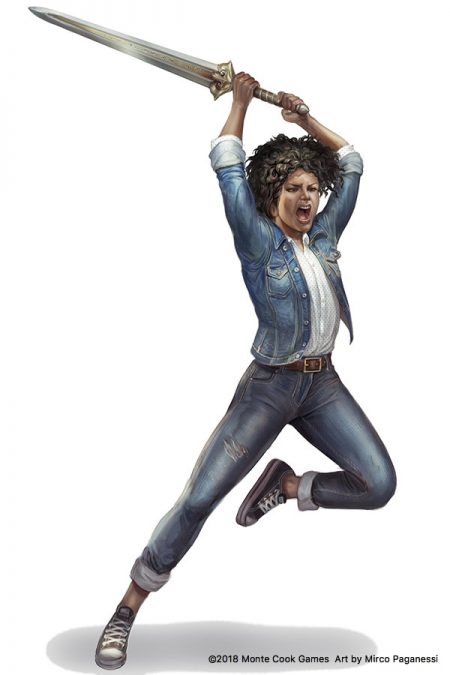So, last time, we took a look at a specific issue that Your Best Game Ever will cover and showed the general approach the book will take. This time, we’ll look at another:
Playing games online
This is a fantastic opportunity that’s really only come to the fore in the last decade or so. It used to be that if your best gaming friends moved across the country, the game was over. But not anymore. Using a variety of methods, from Skype to Roll20 to a number of others, if everyone in the game has a webcam and a mic, you can all be sitting around the same virtual table even though you’re miles apart.
But while the technology’s not too challenging, running and playing the game can be. If you’re used to sitting in the same room with your friends, you’ll likely encounter what I’m going to call the invisible barrier between you all. You’re not in the same physical space, so a distraction for one person (a TV on in the next room, for example) isn’t a distraction for everyone else. Player attention wanders in a way that it might not if you were in the same locale—you’re all (by definition) sitting in front of a computer, and so you check email. Or social media. The technology gives the illusion of proximity, but there’s still a psychological distance between you all. The issue really comes down to communication and engagement.

The invisible barrier’s not insurmountable. You just need a few guidelines to help get around it. And the first one is recognizing that it’s there. And recognizing that it’s going to affect different players differently. The person in the later time zone sitting in the dark starts to get sleepy. The person who’s more prone to distraction finds more opportunity to let their mind wander. Players who otherwise would be attentive if they were sitting among their friends just find that they cannot sit alone in a room doing nothing while someone else takes their turn; they start checking Instagram. Or playing a game on their phone.
The second guideline is to use visuals to stimulate interest and engagement. Many apps allow for screen sharing, or even have a built-in way to show an image or a map to help immerse everyone in the game. In some ways, this is an advantage to online gaming, particularly if you’re using an app that can actually show everyone the same map, indicate character positions on that map, and so on. And visuals aren’t just the GM’s responsibility. Players can find artwork that represents their character, or their favorite item, or the little town where they’re from.
Ironically, online gaming might be the time to break out some physical props—specifically, those that can be held up to the webcam for everyone to see. The bad guy just inflicted 7 points of damage on one of the PCs? The GM can hold up a playing card with a 7 on it. The player can then hold up their own card with a 7. Or maybe they hold up a 3, because that’s how many hit points they have left. This works for initiative and other mechanics as well.
Another way to deal with the invisible barrier is to turn up the volume on player agency. It’s always everyone’s responsibility to keep up the energy level in a game, and to help contribute to the story and make things interesting for everyone else. Players should take more upon themselves in an online game. One way to do that is for the group to agree that the players have more agency over the narrative and the world. Everyone’s going to pay extra attention—despite the barrier—if they can make suggestions to what’s going on around them. To facilitate this, the GM can call upon the players for contributions even—or perhaps particularly—when it’s not their turn. “Keith, what does the guard say when Sarah’s character approaches?” “Richard, what are the bystanders in the back doing?” This increases engagement. (This kind of thing isn’t everyone’s play style, of course, but it might be something to try. It’s something we’ll discuss for all games in further depth—and regardless of what your preference is, understanding where player agency over the narrative and the setting begins and ends is something the whole group should be comfortable with.)
These suggestions address engagement, but the other problem that occurs in online gaming is communication. Unlike at a table, online you can really only have one conversation at a time because if more than one person is speaking, you won’t hear any of them. Everyone on your screen has the same emphasis, while at a table, it’s likely there’s more focus on the GM (and certainly on the people you happen to be seated near).
Again, use technology rather fight against it. A player can text or direct message another player or the GM. The GM can give personal, pertinent information to just one player in the same way. Just don’t spend so much time typing that no one’s actually talking to each other. The GM has an advantage, though, as they can have messages of this sort already typed into a document and ready to quickly paste into a chat window.
 This is only the start of what will be an entire chapter in Your Best Game Ever, but as I said before, I just want to give you an idea of the kind of material will be in this book, and why everyone who plays roleplaying games will want it on their shelf. This isn’t a book that advocates a certain play style. Instead, it embraces them all. If you’re a kick-down-the-door-and-kill-the-orc player, great! If you’re a deep, immersive storyteller, that’s great too. Either way, though, I want to really examine all the options and see if there aren’t some suggestions that can make your next game your best game ever.
This is only the start of what will be an entire chapter in Your Best Game Ever, but as I said before, I just want to give you an idea of the kind of material will be in this book, and why everyone who plays roleplaying games will want it on their shelf. This isn’t a book that advocates a certain play style. Instead, it embraces them all. If you’re a kick-down-the-door-and-kill-the-orc player, great! If you’re a deep, immersive storyteller, that’s great too. Either way, though, I want to really examine all the options and see if there aren’t some suggestions that can make your next game your best game ever.
In Part 3, I’ll cover one more topic—character arcs that can give your characters both depth and the impetus to set their own goals.
